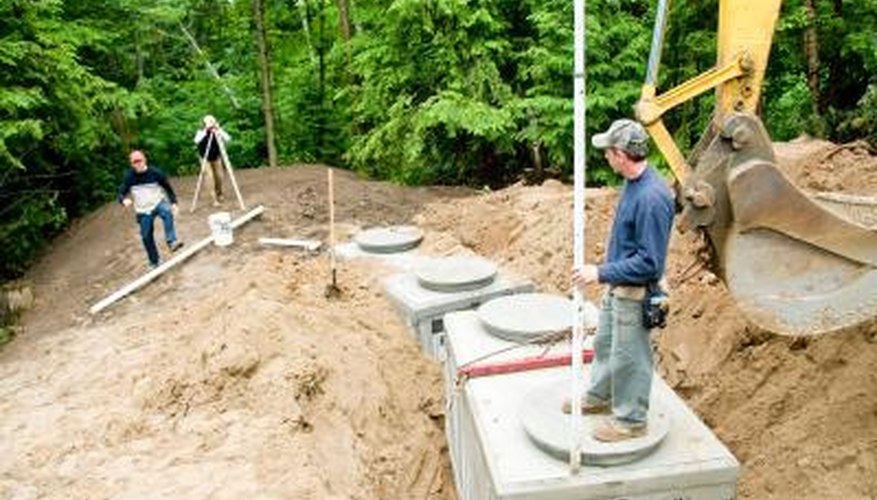People who don't have access to centralised public sewer systems often handle their household wastewater, or sewage, with septic tanks. A septic system is a series of pipes and tanks that filter waste and guide it to a drain field. A drop box and a distribution box can improve a system's fertilising effects and prevent the hazardous concentration of untreated sewage water.
Septic System Structure
A septic system treats a building's sewage, refining the wastewater in a septic tank before moving it along to a drain field. A septic system does not require complex machinery. Many septic systems use gravity to pull wastewater down from the building to the underground septic tank, then to the lower-level drop or distribution boxes. From there, the water flows through distribution pipes into the drain field, seeping through the pipes' perforations. Organisms in the soil break down harmful components, and the earth itself filters the water before it reaches the groundwater. The end point of a septic system is often in the owner's yard.
- A septic system treats a building's sewage, refining the wastewater in a septic tank before moving it along to a drain field.
- Many septic systems use gravity to pull wastewater down from the building to the underground septic tank, then to the lower-level drop or distribution boxes.
Drop Box and Serial Diffusion
The drop box is a tank of effluent fluid where the inflow of wastewater is higher than the outflow. Its main purpose is to account for sloping properties by creating a point where wastewater can drop directly downward, before continuing through the pipe system. You can use the drop box to create a serial distribution system, where a series of drop boxes direct the flow. After one segment of the drainage system is saturated, additional flow can move on to another set of distribution pipes. Users can block flow to certain system segments, letting wastewater disperse in different areas at different times.
- The drop box is a tank of effluent fluid where the inflow of wastewater is higher than the outflow.
- Its main purpose is to account for sloping properties by creating a point where wastewater can drop directly downward, before continuing through the pipe system.
Distribution Box and Equal Diffusion
A distribution box ensures that wastewater disperses evenly into a drain field. The distribution box passes effluent water laterally in multiple directions to different points in the drain field. The outlet pipes are all on the same level, so accumulated water in a distribution box flows in all outward directions simultaneously. Because of this design, it is critical that a distribution box be level, or water will flow unevenly out of the box, causing waste to collect in one section of the property. The concentration of wastewater can create health hazards and other problems.
- A distribution box ensures that wastewater disperses evenly into a drain field.
- The distribution box passes effluent water laterally in multiple directions to different points in the drain field.
Drop Box vs. Distribution Box
A drop box tends to have fewer holes than a distribution box, because a drop box only needs to take water in and send it out. Different distribution boxes can have different numbers of holes, depending on the number of distribution channels. Besides the variation in number of holes, the main difference is in function. A drop box handles elevation changes and creates serial distribution; a distribution box stays level and creates simultaneous distribution.
- A drop box tends to have fewer holes than a distribution box, because a drop box only needs to take water in and send it out.
- Different distribution boxes can have different numbers of holes, depending on the number of distribution channels.
Importance to Septic Systems
Some systems bypass the drop box or distribution box altogether, and simply run one pipe from the septic tank out to the drain field. However, most modern systems use drop boxes or distribution boxes, because a single distribution pipe is no longer considered adequate for most households.
